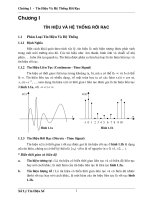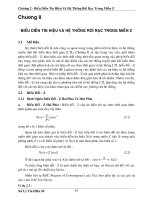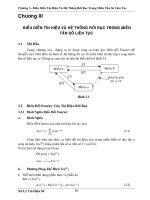LABEX 4.1 Xử lý tín hiệu số
Bạn đang xem bản rút gọn của tài liệu. Xem và tải ngay bản đầy đủ của tài liệu tại đây (922.46 KB, 16 trang )
Laboratory Exercise 4
LINEAR, TIMEINVARIANT DISCRETETIME SYSTEMS:
FREQUENCYDOMAIN REPRESENTATIONS
4.1
TRANSFER FUNCTION AND FREQUENCY RESPONSE
Project 4.1 Transfer Function Analysis
Answers:
Q4.1
The modified Program P3_1 to compute and plot the magnitude and phase spectra of a
moving average filter of Eq. (2.13) for 0 2 is shown below:
% Program P3_1
plot(w/pi,abs(h));grid
% Evaluation of the DTFT
title('Magnitude Spectrum |
clf;
H(e^{j\omega})|')
% Compute the frequency samples
xlabel('\omega /\pi');
of the DTFT
ylabel('Amplitude');
w = 0:8*pi/511:2*pi;
subplot(2,1,2)
m = 5;
plot(w/pi,angle(h));grid
num =ones(1,m)/m;
title('Phase Spectrum
h = freqz(num, 1, w);
arg[H(e^{j\omega})]')
% Plot the DTFT
xlabel('\omega /\pi');
subplot(2,1,1)
ylabel('Phase in radians');
This program was run for the following three different values of
the corresponding frequency responses are shown below:
Magnitude Spectrum |H(ej )|
1
Amplitude
M and the plots of
0.5
0
0
0.2
0.4
0.6
0.8
1
1.2
1.4
1.6
1.8
2
1.6
1.8
2
/
j
Phase Spectrum arg[H(e )]
Phase in radians
4
2
0
2
4
0
0.2
0.4
0.6
0.8
1
1.2
1.4
/
The types of symmetries exhibited by the magnitude and phase spectra are due to
The type of filter represented by the moving average filter is
1
The results of Question Q2.1 can now be explained as follo Q4.2
The plot of the frequency response of the causal LTI discrete-time system of
Question Q4.2 obtained using the modified program is given below :
Magnitude Spectrum |H(ej )|
Amplitude
1
0.5
0
0
0.1
0.2
0.3
0.4
0.5
0.6
0.7
0.8
0.9
1
0.8
0.9
1
/
Phase Spectrum arg[H(ej )]
Phase in radians
2
1
0
1
2
0
0.1
0.2
0.3
0.4
0.5
0.6
0.7
/
The type of filter represented by this transfer function is
Q4.3
The plot of the frequency response of the causal LTI discrete-time system of
Question Q4.3 obtained using the modified program is given below :
Magnitude Spectrum |H(ej )|
Amplitude
1
0.5
0
0
0.1
0.2
0.3
0.4
0.5
0.6
0.7
0.8
0.9
1
0.8
0.9
1
/
Phase Spectrum arg[H(ej )]
Phase in radians
4
2
0
2
4
0
0.1
0.2
0.3
0.4
0.5
0.6
0.7
/
The type of filter represented by this transfer function is
The difference between the two filters of Questions 4.2 and 4.3 is
nhau
2
– phổ pha khác
I shall choose the filter of Question Q4.2 for the following reason Vì đáp ứng pha
tốt hơn
Q4.4
The group delay of the filter specified in Question Q4.4 and obtained using the
function grpdelay is shown below:
Magnitude Spectrum |H(ej )|
Amplitude
8
6
4
2
0
0
0.1
0.2
0.3
0.4
0.5
0.6
0.7
0.8
0.9
1
0.8
0.9
1
/
Phase Spectrum arg[H(ej )]
Phase in radians
1
0.5
0
0.5
1
0
0.1
0.2
0.3
0.4
0.5
0.6
0.7
/
From this plot we make the following observations :
Q4.5
The plots of the first 100 samples of the impulse responses of the two filters of
Questions 4.2 and 4.3 obtained using the program developed in Question Q3.50
are shown below:
impule
0.8
0.6
0.4
Amplitude
0.2
0
0.2
0.4
0.6
0.8
1
1.2
0
10
20
30
40
50
60
70
80
90
100
/
3
7
6
impule
x 10
5
4
3
Amplitude
2
1
0
1
2
3
4
0
10
20
30
40
50
60
70
80
90
100
/
From these plots we make the following observations :
Q4.6
The pole-zero plots of the two filters of Questions 4.2 and 4.3 developed using
zplane are shown below:
2
1.5
Imaginary Part
1
0.5
0
0.5
1
1.5
2
2.5
2
1.5
1
0.5
0
0.5
Real Part
1
1.5
2
2.5
2
1.5
Imaginary Part
1
0.5
0
0.5
1
1.5
2
2.5
2
1.5
1
0.5
0
0.5
Real Part
1
1.5
2
2.5
From these plots we make the following observations : Ta có các cực khác nhau
4
4.2
TYPES OF TRANSFER FUNCTIONS
Project 4.2 Filters
A copy of Program P4_1 is given below:
% Program P4_1
% Impulse Response of Truncated Ideal Lowpass Filter
clf;
fc = 0.25;
n = [-6.5:1:6.5];
y = 2*fc*sinc(2*fc*n);k = n+6.5;
stem(k,y);title('N = 13');axis([0 13 -0.2 0.6]);
xlabel('Time index n');ylabel('Amplitude');grid;
Answers:
Q4.7
The plot of the impulse response of the approximation to the ideal lowpass filter
obtained using Program P4_1 is shown below:
N = 13
0.6
0.5
0.4
Amplitude
0.3
0.2
0.1
0
0.1
0.2
0
2
4
6
8
Time index n
10
12
The length of the FIR lowpass filter is 13
The statement in Program P4_1 determining the filter length is n = [6.5:1:6.5];
The parameter controlling the cutoff frequency is
Q4.8
– Fc = 0.25
The required modifications to Program P4_1 to compute and plot the impulse
response of the FIR lowpass filter of Project 4.2 with a length of 20 and a cutoff
frequency of c = 0.45 are as indicated below:
% Program P4_1
% Impulse Response of Truncated Ideal Lowpass Filter
clf;
fc = 0.45;
n = [-10:1:10];
0.8
y = 2*fc*sinc(2*fc*n);k = n+10;
stem(k,y);title('N = 20');axis([0 20 -0.2
0.6
1]);
xlabel('Time index
0.4
n');ylabel('Amplitude');grid;
Amplitude
N = 20
0.2
5
0
0.2
0
2
4
6
8
10
12
Time index n
14
16
18
20
The plot generated by running the modified program is given below :
Q4.9
The required modifications to Program P4_1 to compute and plot the impulse
response of the FIR lowpass filter of Project 4.2 with a length of 15 and a cutoff
frequency of c = 0.65 are as
indicated below:
% Program P4_1
% Impulse Response of Truncated Ideal
Lowpass Filter
clf;
fc = 0.65;
n = [-7.5:1:7.5];
y = 2*fc*sinc(2*fc*n);k = n+7.5;
stem(k,y);title('N = 15');axis([0 20
-0.2 0.6]);
xlabel('Time index
n');ylabel('Amplitude');grid;
The plot generated by running
modified program is given below:
N = 15
0.6
0.5
0.4
Amplitude
0.3
0.2
0.1
0
0.1
0.2
0
5
10
15
Time index n
the
The MATLAB program to compute and plot the amplitude response of the FIR lowpass filter of Project 4.2 is given below:
N = 13
0.6
% Program P4_1
% Impulse Response of Truncated Ideal
0.5
Lowpass Filter
0.4
clf;
fc = 0.25;
0.3
n = [-6.5:1:6.5];
y = 2*fc*sinc(2*fc*n);k = n+6.5;
0.2
plot(k,y);title('N = 13');axis([0 13 -0.2
0.1
0.6]);
xlabel('Time index
0
n');ylabel('Amplitude');grid;
Amplitude
Q4.10
Plots of the amplitude response of the
lowpass filter for several values of N are
shown below:
N = 15
6
0.1
0.2
0
2
4
6
8
Time index n
10
12
N = 15
0.6
0.5
0.4
Amplitude
0.3
0.2
0.1
0
0.1
0.2
0
2
4
6
8
Time index n
10
12
N= 19
N = 19
0.6
0.5
0.4
Amplitude
0.3
0.2
0.1
0
0.1
0.2
0
2
4
6
8
Time index n
10
12
From these plots we can make the following observations – Không thay đổi theo N
A copy of Program P4_2 is given below:
% Program P4_2
[g,w] = gain(num,1);
% Gain Response of a Moving
plot(w/pi,g);grid
Average Lowpass Filter
axis([0 1 -50 0.5])
clf;
xlabel('\omega
M = 2;
/\pi');ylabel('Gain in dB');
num = ones(1,M)/M;
title(['M = ', num2str(M)])
Answers:
Q4.11
A plot of the gain response of a length-2 moving aver age filter obtained using
Program P4_2 is shown below:
7
M = 2
0
5
10
Gain in dB
15
20
25
30
35
40
45
50
0
0.1
0.2
0.3
0.4
0.5
0.6
0.7
0.8
0.9
1
/
From the plot it can be seen that the 3-dB cutoff frequency is at – 0.5
Q4.12
The required modifications to Program P4_2 to compute and plot the gain response
of a cascade of K length-2 moving average filters are given below:
% Program P4_2
% Gain Response of a Moving Average Lowpass Filter
clf;
M = 2;
num =[1 1]/M;
[g,w] = gain(num,1);
plot(w/pi,g);grid
axis([0 1 -50 0.5])
xlabel('\omega /\pi');ylabel('Gain in dB');
title(['M = ', num2str(M)])
The plot of the gain response for a cascade of 3 sections obtained using the
modified program is shown below:
M = 3
0
5
10
Gain in dB
15
20
25
30
35
40
45
50
0
0.1
0.2
0.3
0.4
0.5
0.6
0.7
0.8
0.9
1
/
From the plot it can be seen that the 3-dB cutoff frequency of the cascade is at
Q4.13
0.31
The required modifications to Program P4_2 to compute and plot the gain response
of the highpass filter of Eq. (4.42) are given below :
% Program P4_2
% Gain Response of a Moving Average Lowpass Filter
8
clf;
M = 5;
num =[1 -1 1 -1 1]/M;
[g,w] = gain(num,1);
plot(w/pi,g);grid
axis([0 1 -50 0.5])
xlabel('\omega /\pi');ylabel('Gain in dB');
title(['M = ', num2str(M)])
The plot of the gain response for
shown below:
M = 5 obtained using the modified program is
M = 5
0
5
10
Gain in dB
15
20
25
30
35
40
45
50
0
0.1
0.2
0.3
0.4
0.5
0.6
0.7
0.8
0.9
1
/
From the plot we can see that the 3-dB cutoff frequency is at – 0.82
Q4.14
From Eq. (4.16) for a 3-dB cutoff frequency
c at 0.45 we obtain = 0.0787
Substituting this value of in Eqs. (4.15) and (4.17) we arrive at the transfer
function of the first-order IIR lowpass and highpass filters, respectively, given by
HLP(z) =
HHP(z) =
The plots of their gain responses obtained using MATLAB are shown below :
9
M = 5
M = 5
0
5
5
10
10
15
15
20
20
Gain in dB
Gain in dB
0
25
30
25
30
35
35
40
40
45
45
50
0
0.1
0.2
0.3
0.4
0.5
0.6
0.7
0.8
0.9
1
50
0
0.1
0.2
0.3
0.4
/
0.5
0.6
0.7
0.8
0.9
1
/
From these plots we observe that the designed filters _______ meet the specifications .
A plot of the magnitude response of
the sum HLP(z) + HHP(z) obtained
using MATLAB is given below:
M = 5
0.1
0
Gain in dB
0.1
From this plot we observe that the two filters
are
0.2
0.3
0.4
0.5
0.6
A plot of the sum of the squaremagnitude responses of HLP(z) and
HHP(z) obtained using MATLAB is given below:
< Insert MATLAB figure(s) here.
paste. >
0.12
0.13
0.14
0.15
0.16 0.17
/
0.18
0.19
0.2
0.21
Copy from figure window(s) and
From this plot we observe that the two filters are
Q4.15
From Eq. (4.24), we get substituting
Substituting this value of
K = 10, B = 1.86
B and c = 0.3 in Eq. (4.23) we obtain = 0.31
Using this value of in Eq. (4.22) we arrive at the transfer function of the cascade
of 10 IIR lowpass filters as
1 – 1 z 1 10
1
1
H LP,10 (z)
(7.85+7.85z )/(2+13.7z )
1
2 1 – z
Substituting
c = 0.3 in Eq. (4.16) we obtain =
10
Using this value of
IIR lowpass filter
in Eq. (4.15) we arrive at the transfer function of a first-order
1 – 1 z 1
H LP,1(z)
(7.7+7.7z1)/(2+13.4z1)
2 1 – z 1
H LP,10 (z) and H LP,1(z) plotted using MATLAB are shown
The gain responses of
below:
HHP
M = 21
0
5
5
10
10
15
15
20
20
Gain in dB
Gain in dB
0
25
30
25
30
35
35
40
40
45
45
50
0
0.1
0.2
0.3
0.4
0.5
0.6
0.7
0.8
0.9
1
50
0
0.1
0.2
0.3
0.4
0.5
0.6
0.7
0.8
0.9
1
/
/
< Insert
From these plots we make the following observation
Q4.16
Substituting
o = 0.61 in Eq. (4.19) we get cos(0.61)
3dB = 0.15 in Eq. (4.20) we get (1 2 )cos(0.15) 2 0,
whose solution yields =
and =
.
Substituting
Substituting the value of and the first value of in Eq. (4.18) we arrive at the
transfer function of the IIR bandpass transfer function
HBP,1(z) =
Substituting the value of and the second value of in Eq. (4.18) we arrive at the
transfer function of the IIR bandpass transfer function
HBP,2(z) =
zplane command we find the pole locations of HBP,1(z) and
HBP,2(z) from which we conclude that the stable transfer function HBP(z) is given
Next using the
by
11
The plot of the gain response of the stable transfer function
HBP(z) obtained using
MATLAB is shown below:
< Insert MATLAB figure(s) here.
paste. >
Copy from figure window(s) and
Using the same value of and in Eq. (4.21) we next obtain the transfer function
of a stable IIR bandstop filter as
HBS(z) =
The plot of the gain response of the transfer function
HBS(z) obtained using
MATLAB is shown below:
< Insert MATLAB figure(s) here.
paste. >
Copy from figure window(s) and
From these plots we observe that the designed filters do/do not meet the
specifications.
A plot of the magnitude response of the sum
HBP(z) + HBS(z) obtained using
MATLAB is given below:
< Insert MATLAB figure(s) here.
paste. >
From this plot we observe that the two filters are
Copy from figure window(s) and
A plot of the sum of the square-magnitude responses of
HBP(z) and HBS(z)
obtained using MATLAB is given below:
< Insert MATLAB figure(s) here.
paste. >
From this plot we observe that the two filters are
Q4.17
Copy from figure window(s) and
The transfer function of a comb filter derived from the prototype FIR lowpass filter
of Eq. (4.38) is given by
G(z) = H0(zL) =
Plots of the magnitude response of the above comb filter for the following values of
L are shown below:
< Insert MATLAB figure(s) here.
paste. >
12
Copy from figure window(s) and
From these plots we observe that the comb filter has _____ notches at
k = _______
= _______and _____ peaks at k = _______ = _______, where k = 0, 1, . . ., _____ .
Q4.18
The transfer function of a comb filter derived from the prototype FIR highpass filter
of Eq. (4.41) with M = 2 is given by
G(z) = H1(zL) =
Plots of the magnitude response of the above comb filter for the following values of
L are shown below
< Insert MATLAB figure(s) here.
paste. >
Copy from figure window(s) and
From these plots we observe that the comb filter has _____ notches at
k =
_______
k = _______.
Type 1 FIR Filter
4
6
Time index n
Type 3 FIR Filter
0
50
0
2
4
6
Time index n
0
50
0
5
Time index n
Type 4 FIR Filter
10
0
5
Time index n
10
100
50
100
50
100
8
Amplitude
Amplitude
13
2
Type 2 FIR Filter
100
Amplitude
Q4.19 A copy of Program P4_3 is given below:
% Program P4_3
% Zero Locations of Linear Phase FIR Filters
clf;
b = [1 -8.5 30.5 -63];
num1 = [b 81 fliplr(b)];
num2 = [b 81 81 fliplr(b)];
num3 = [b 0 -fliplr(b)];
num4 = [b 81 -81 -fliplr(b)];
n1 = 0:length(num1)-1;
n2 = 0:length(num2)-1;
subplot(2,2,1); stem(n1,num1);
xlabel('Time index n');ylabel('Amplitude'); grid;
title('Type 1 FIR Filter');
subplot(2,2,2); stem(n2,num2);
xlabel('Time index n');ylabel('Amplitude'); grid;
title('Type 2 FIR Filter');
subplot(2,2,3); stem(n1,num3);
xlabel('Time index n');ylabel('Amplitude'); grid;
title('Type 3 FIR Filter');
subplot(2,2,4); stem(n2,num4);
xlabel('Time index n');ylabel('Amplitude'); grid;
title('Type 4 FIR Filter');
pause
100
subplot(2,2,1); zplane(num1,1);
50
title('Type 1 FIR Filter');
0
subplot(2,2,2); zplane(num2,1);
title('Type 2 FIR Filter');
50
subplot(2,2,3); zplane(num3,1);
100
title('Type 3 FIR Filter');
0
subplot(2,2,4); zplane(num4,1);
title('Type 4 FIR Filter');
100
Amplitude
and _____ peaks at
8
50
0
50
100
disp('Zeros of Type
disp(roots(num1));
disp('Zeros of Type
disp(roots(num2));
disp('Zeros of Type
disp(roots(num3));
disp('Zeros of Type
disp(roots(num4));
-
1 FIR Filter are');
2 FIR Filter are');
3 FIR Filter are');
4 FIR Filter are');
-
Các tín hiệu kế tiếp nhau cho ta thấy các giá trị M của tín hiệu là khác nhau : tín
hiệu 1 và 3 thì giá trị M chẵn và tín hiệu 2 và 4 thì giá trị M lẽ.
Tín hiệu 1 có M=8 và a = 1.979
Tín hiệu 2 có M= 9 và a = 1
Tín hiệu 3 có M= 8 và a = 0
Tín hiệu 4 có M = 9 và a = 1
-
Filter #1 has zeros at z
=
-
Filter #2 has zeros at z
=
-
Filter #3 has zeros at z
=
-
Filter #4 has zeros at z
=
The plots of the impulse responses of the four FIR filters generated by running
Program P4_3 are given below:
< Insert MATLAB figure(s) here.
paste. >
Copy from figure window(s) and
From the plots we make the following observations :
Filter #1 is of length __________ with a __________ impulse response and is
therefore a Type __ linear-phase FIR filter.
Filter #2 is of length __________ with a __________ impulse response and is
therefore a Type __ linear-phase FIR filter.
Filter #3 is of length __________ with a __________ impulse response and is
therefore a Type __ linear-phase FIR filter.
Filter #4 is of length __________ with a __________ impulse response and is
therefore a Type __ linear-phase FIR filter.
From the zeros of these filters generated by Program P4_3 we observe that :
14
Filter #1 has zeros at z
=
Filter #2 has zeros at z
=
Filter #3 has zeros at z
=
Filter #4 has zeros at z
=
Plots of the phase response of each of these filters obtained using MATLAB are
shown below:
< Insert MATLAB figure(s) here.
paste. >
Copy from figure window(s) and
From these plots we conclude that each of these filters have __________ phase.
The group delay of Filter # 1 is
The group delay of Filter # 2 is
The group delay of Filter # 3 is
The group delay of Filter # 4 is
50
Amplitude
Amplitude
15
Amplitude
The plots of the impulse responses of the four FIR filters generated by running
Program P4_3 are given below:
% Program P4_3
% Zero Locations of Linear Phase FIR Filters
clf;
b = [1 -8.5 30.5 -63];
num1 = [b 81 fliplr(b)];
num2 = [b 81 81 fliplr(b)];
num3 = [b 0 -fliplr(b)];
num4 = [b 81 -81 -fliplr(b)];
n1 = 0:length(num1)-1;
n2 = 0:length(num2)-1;
subplot(2,2,1); stem(n1,num1);
xlabel('Time index n');ylabel('Amplitude'); grid;
title('Type 1 FIR Filter');
subplot(2,2,2); stem(n2,num2);
xlabel('Time index n');ylabel('Amplitude'); grid;
title('Type 2 FIR Filter');
subplot(2,2,3); stem(n1,num3);
Type 1 FIR Filter
Type 2 FIR Filter
xlabel('Time index
100
100
n');ylabel('Amplitude'); grid;
50
50
title('Type 3 FIR Filter');
subplot(2,2,4); stem(n2,num4);
0
0
xlabel('Time index
50
50
n');ylabel('Amplitude'); grid;
100
100
title('Type 4 FIR Filter');
0
2
4
6
8
0
5
Time index n
Time index n
pause
Type 3 FIR Filter
Type 4 FIR Filter
subplot(2,2,1); zplane(num1,1);
100
100
title('Type 1 FIR Filter');
Amplitude
Q4.20
0
50
100
0
2
4
6
Time index n
8
10
50
0
50
100
0
5
Time index n
10
subplot(2,2,2); zplane(num2,1);
title('Type 2 FIR Filter');
subplot(2,2,3); zplane(num3,1);
title('Type 3 FIR Filter');
subplot(2,2,4); zplane(num4,1);
title('Type 4 FIR Filter');
disp('Zeros of Type 1 FIR Filter
disp(roots(num1));
disp('Zeros of Type 2 FIR Filter
disp(roots(num2));
disp('Zeros of Type 3 FIR Filter
disp(roots(num3));
disp('Zeros of Type 4 FIR Filter
disp(roots(num4));
-
are');
are');
are');
are');
Các tín hiệu kế tiếp nhau cho ta thấy các giá trị M của tín hiệu là khác nhau : tín
hiệu 1 và 3 thì giá trị M chẵn và tín hiệu 2 và 4 thì giá trị M lẽ.
Tín hiệu 1 có M=8 và a = 1.979
Tín hiệu 2 có M= 9 và a = 1
Tín hiệu 3 có M= 8 và a = 0
Tín hiệu 4 có M = 9 và a = 1
16









